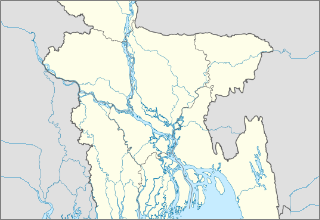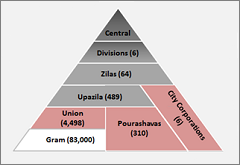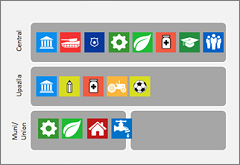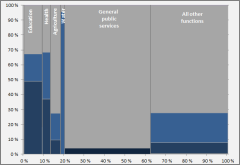 Country Profile Background
Country Profile Background
The government of Bangladesh has committed to bringing “basic public services to people’s doorsteps”. However, with a population of around 150 million people and a highly centralized and hierarchical government structure, the country is widely considered to be among the most centralized in the world. Since 2006, the government has been pursuing a series of reforms to strengthen the role of local bodies in the public sector. While local elections were held in 2008, most of the new legislation empowering local bodies is yet to be fully implemented.
 Organizational/Governance Structure of the Public Sector
Organizational/Governance Structure of the Public Sector
The structure of the public sector in Bangladesh is formed by several deconcentrated administrative tiers (Divisions, Zila and Upazila), for which authority, human resources and funding flow down from the center. The Constitution of Bangladesh states that local governance in every administrative unit of the Republic shall be entrusted to elected councils. Although Upazila Chairmen and Councils were elected in 2008, in practice, these locally elected officials do not have executive or regulatory power over local affairs. Only the lowest local government level in Bangladesh (Union Councils, municipalities and City Corporations) should be considered true local self-government units, with a tradition of elected local government leadership.
 Functional Responsibilities of the Local Public Sector
Functional Responsibilities of the Local Public Sector
Functions and expenditure responsibilities in Bangladesh are not always clearly assigned. In some cases, different laws assign functions to different levels, and there are gaps between the legislated assignment of functions and the actual situation. In practice, most front-line public services (including public education and health services) are delivered at the Upazila level, which is the lowest level of state administration. Union Councils and urban local bodies are responsible for many local economic activities and other functions that are strictly local in nature. Across the board, central line ministries play a significant role in managing the local delivery of sectoral public services.
 Fiscal Profile of the Public Sector
Fiscal Profile of the Public Sector
The absence of detailed budget data sources makes it difficult to disentangle exactly what share of public sector expenditures finds its way to the local public sector to fund front-line public services in Bangladesh. Estimates for FY 2010/11 suggest that approximately 3.1% of public spending in the country is done by Union Councils and urban local bodies. In addition, roughly 8.4% of public expenditures takes place through deconcentrated bodies at the Zila and Upazila level, whereas an additional 12.5% of spending is contained in central line ministries budgets in direct support of ‘local’ front line service delivery. These estimates suggest that in total, only about 24% of public expenditures are devoted to the local public sector.
No complete and consistent data are available for the revenues of Union Councils and urban local governments in Bangladesh. It is clear, however, that local governments have only limited access to financial resources. For instance, total revenues for Union Councils in 2007/08 (including own sources revenues and intergovernmental transfers) amounted to only around Taka 45 (or about US$ 0.70) per person (Fox and Menon, 2008). Less than 30% of this came from own revenue sources. Total per capita revenues for municipalities were considerably higher, averaging around Taka 1930 per person, of which Taka 580 was generated from own revenue sources.
 Institutional Profile of the Local Public Sector
Institutional Profile of the Local Public Sector
The Upazila level is the main level where public services are delivered within the local public sector in Bangladesh. Despite recent Upazila elections, however, neither elected nor appointed Upazila-level officials have meaningful discretion over any aspect of Upazila operations. For instance, Upazilas do not prepare or adopt their own budgets; they cannot hire and fire their own staff; and have no meaningful own revenue sources to speak of. Although Union Councils and urban local governments have a greater degree of discretion (and are more accountable to the local population), these local entities only account for a small share of local public spending at the current time.
Country Profile Information
Complete LPS Country Profile: Bangladesh (PDF)
Complete LPS Country Profile: Bangladesh (XLS)





